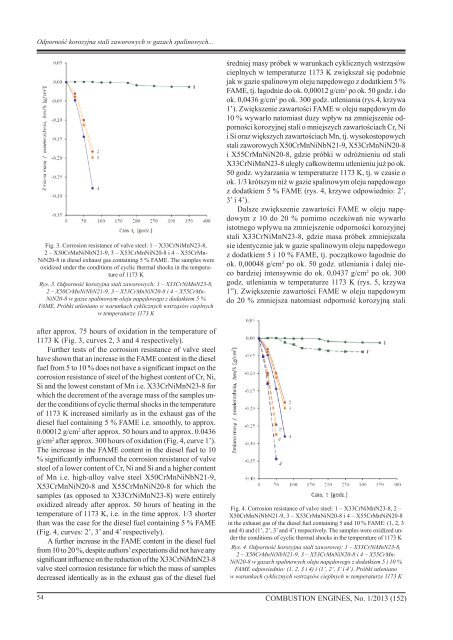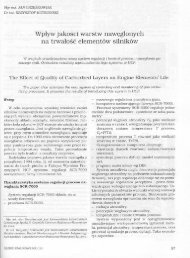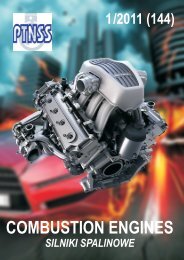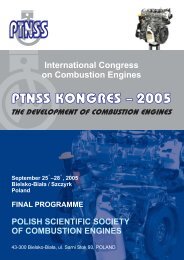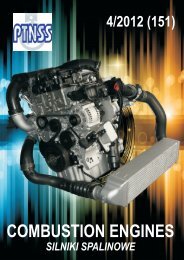You also want an ePaper? Increase the reach of your titles
YUMPU automatically turns print PDFs into web optimized ePapers that Google loves.
Odporność korozyjna stali zaworowych w gazach spalinowych...<br />
Fig. 3. Corrosion resistance of valve steel: 1 – X33CrNiMnN23-8,<br />
2 – X50CrMnNiNbN21-9, 3 – X53CrMnNiN20-8 i 4 – X55CrMn-<br />
NiN20-8 in diesel exhaust gas containing 5 % FAME. The samples were<br />
oxidized under the conditions of cyclic thermal shocks in the temperature<br />
of 1173 K<br />
Rys. 3. Odporność korozyjna stali zaworowych: 1 – X33CrNiMnN23-8,<br />
2 – X50CrMnNiNbN21-9, 3 – X53CrMnNiN20-8 i 4 – X55CrMn-<br />
NiN20-8 w gazie spalinowym oleju napędowego z dodatkiem 5 %<br />
FAME. Próbki utleniano w warunkach cyklicznych wstrząsów cieplnych<br />
w temperaturze 1173 K<br />
after approx. 75 hours of oxidation in the temperature of<br />
1173 K (Fig. 3, curves 2, 3 and 4 respectively).<br />
Further tests of the corrosion resistance of valve steel<br />
have shown that an increase in the FAME content in the diesel<br />
fuel from 5 to 10 % does not have a significant impact on the<br />
corrosion resistance of steel of the highest content of Cr, Ni,<br />
Si and the lowest constant of Mn i.e. X33CrNiMnN23-8 for<br />
which the decrement of the average mass of the samples under<br />
the conditions of cyclic thermal shocks in the temperature<br />
of 1173 K increased similarly as in the exhaust gas of the<br />
diesel fuel containing 5 % FAME i.e. smoothly, to approx.<br />
0.00012 g/cm 2 after approx. 50 hours and to approx. 0.0436<br />
g/cm 2 after approx. 300 hours of oxidation (Fig. 4, curve 1’).<br />
The increase in the FAME content in the diesel fuel to 10<br />
% significantly influenced the corrosion resistance of valve<br />
steel of a lower content of Cr, Ni and Si and a higher content<br />
of Mn i.e. high-alloy valve steel X50CrMnNiNbN21-9,<br />
X53CrMnNiN20-8 and X55CrMnNiN20-8 for which the<br />
samples (as opposed to X33CrNiMnN23-8) were entirely<br />
oxidized already after approx. 50 hours of heating in the<br />
temperature of 1173 K, i.e. in the time approx. 1/3 shorter<br />
than was the case for the diesel fuel containing 5 % FAME<br />
(Fig. 4, curves: 2’, 3’ and 4’ respectively).<br />
A further increase in the FAME content in the diesel fuel<br />
from 10 to 20 %, despite authors’ expectations did not have any<br />
significant influence on the reduction of the X33CrNiMnN23-8<br />
valve steel corrosion resistance for which the mass of samples<br />
decreased identically as in the exhaust gas of the diesel fuel<br />
średniej masy próbek w warunkach cyklicznych wstrząsów<br />
cieplnych w temperaturze 1173 K zwiększał się podobnie<br />
jak w gazie spalinowym oleju napędowego z dodatkiem 5 %<br />
FAME, tj. łagodnie do ok. 0,00012 g/cm 2 po ok. 50 godz. i do<br />
ok. 0,0436 g/cm 2 po ok. 300 godz. utleniania (rys.4, krzywa<br />
1’). Zwiększenie zawartości FAME w oleju napędowym do<br />
10 % wywarło natomiast duzy wpływ na zmniejszenie odporności<br />
korozyjnej stali o mniejszych zawartościach Cr, Ni<br />
i Si oraz większych zawartościach Mn, tj. wysokostopowych<br />
stali zaworowych X50CrMnNiNbN21-9, X53CrMnNiN20-8<br />
i X55CrMnNiN20-8, gdzie próbki w odróżnieniu od stali<br />
X33CrNiMnN23-8 uległy całkowitemu utlenieniu już po ok.<br />
50 godz. wyżarzania w temperaturze 1173 K, tj. w czasie o<br />
ok. 1/3 krótszym niż w gazie spalinowym oleju napędowego<br />
z dodatkiem 5 % FAME (rys. 4, krzywe odpowiednio: 2’,<br />
3’ i 4’).<br />
Dalsze zwiększenie zawartości FAME w oleju napędowym<br />
z 10 do 20 % pomimo oczekiwań nie wywarło<br />
istotnego wpływu na zmniejszenie odporności korozyjnej<br />
stali X33CrNiMnN23-8, gdzie masa próbek zmniejszała<br />
sie identycznie jak w gazie spalinowym oleju napędowego<br />
z dodatkiem 5 i 10 % FAME, tj. początkowo łagodnie do<br />
ok. 0,00048 g/cm 2 po ok. 50 godz. utleniania i dalej nieco<br />
bardziej intensywnie do ok. 0,0437 g/cm 2 po ok. 300<br />
godz. utleniania w temperaturze 1173 K (rys. 5, krzywa<br />
1”). Zwiększenie zawartości FAME w oleju napędowym<br />
do 20 % zmniejsza natomiast odporność korozyjną stali<br />
Fig. 4. Corrosion resistance of valve steel: 1 – X33CrNiMnN23-8, 2 –<br />
X50CrMnNiNbN21-9, 3 – X53CrMnNiN20-8 i 4 – X55CrMnNiN20-8<br />
in the exhaust gas of the diesel fuel containing 5 and 10 % FAME: (1, 2, 3<br />
and 4) and (1’, 2’, 3’ and 4’) respectively. The samples were oxidized under<br />
the conditions of cyclic thermal shocks in the temperature of 1173 K<br />
Rys. 4. Odporność korozyjna stali zaworowej: 1 – X33CrNiMnN23-8,<br />
2 – X50CrMnNiNbN21-9, 3 – X53CrMnNiN20-8 i 4 – X55CrMn-<br />
NiN20-8 w gazach spalinowych oleju napędowego z dodatkiem 5 i 10 %<br />
FAME odpowiednio: (1, 2, 3 i 4) i (1’, 2’, 3’ i 4’). Próbki utleniano<br />
w warunkach cyklicznych wstrząsów cieplnych w temperaturze 1173 K<br />
54 <strong>COMBUSTION</strong> <strong>ENGINES</strong>, No. 1/2013 (152)


